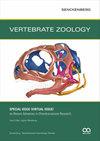New mandibular remains of Callistoe (Metatheria, Sparassodonta) reveal unexpected anatomical, functional, and evolutionary aspects of this carnivorous genus
IF 2.4
2区 生物学
Q1 ZOOLOGY
引用次数: 3
Abstract
We present a detailed description of the anatomy of the dentary and lower teeth of a new specimen of Callistoe vincei, a large carnivorous metatherian from the Eocene (?Ypresian) of northwestern Argentina. The recently collected specimen is a young adult represented by a partial right dentary with the canine, p1, roots of p3, and very well-preserved m1 to m4. The description includes a comparison with the holotype specimen, a much older individual, and other closely related large sparassodonts (e.g., Arminiheringia). The analysis of this new material allowed identifying plesiomorphic molar features in Callistoe, such as the presence of a reduced metaconid on the m3 and a tricuspated, basined talonid on m1–m3. We also described the mesowear facets in the lower dentition, showing that the self-sharpening facet typically present in extinct and extant placental and some marsupial carnivorous forms, was absent in Callistoe. The presence of a short-term cutting edge in the trigonid related to the thinness of the enamel layer, and the associated tooth wear susceptibility, were likely compensated by a dental mechanism (overeruption) to maintain occlusal contact among antagonist teeth. This process could explain the marked extrusion of the tooth roots observed in Callistoe as well as in other large closely related members of the group.Callistoe(Metatheria,Sparassodonta)的新下颌遗骸揭示了这个食肉属出乎意料的解剖、功能和进化方面
我们详细描述了阿根廷西北部始新世(?伊普雷西阶)的一个大型肉食性变兽纲卡利斯托动物的新标本的牙齿和下牙齿的解剖结构。最近采集的标本是一个年轻的成年标本,其代表是一个部分右齿,犬齿p1,p3的根,保存非常完好的m1到m4。该描述包括与正模标本的比较,正模标本是一个年龄大得多的个体,以及其他亲缘关系密切的大型斯巴达(如Arminiherinia)。对这种新材料的分析使我们能够识别卡利斯托的准同形臼齿特征,例如m3上存在减少的异囊菌和m1–m3上存在三尖化、碱化的talonid。我们还描述了下齿列中的中磨小面,表明自磨小面通常存在于已灭绝和现存的胎盘和一些有袋食肉动物中,而在卡利斯托中则不存在。与釉质层薄相关的三角区短期切削刃的存在以及相关的牙齿磨损易感性,可能通过牙齿机制(过度断裂)来补偿,以保持对立牙齿之间的咬合接触。这一过程可以解释在卡利斯托以及该群体中其他大型近亲中观察到的牙根明显挤压的原因。
本文章由计算机程序翻译,如有差异,请以英文原文为准。
求助全文
约1分钟内获得全文
求助全文
来源期刊

Vertebrate Zoology
ZOOLOGY-
CiteScore
4.00
自引率
19.00%
发文量
42
审稿时长
>12 weeks
期刊介绍:
Research fields covered by VERTEBRATE ZOOLOGY are taxonomy, morphology, anatomy, phylogeny (molecular and morphology-based), historical biogeography, and palaeontology of vertebrates.
 求助内容:
求助内容: 应助结果提醒方式:
应助结果提醒方式:


